Haoxing Ren
Timing Analysis Agent: Autonomous Multi-Corner Multi-Mode (MCMM) Timing Debugging with Timing Debug Relation Graph
Apr 15, 2025Abstract:Timing analysis is an essential and demanding verification method for Very Large Scale Integrated (VLSI) circuit design and optimization. In addition, it also serves as the cornerstone of the final sign-off, determining whether the chip is ready to be sent to the semiconductor foundry for fabrication. Recently, as the technology advance relentlessly, smaller metal pitches and the increasing number of devices have led to greater challenges and longer turn-around-time for experienced human designers to debug timing issues from the Multi-Corner Multi-Mode (MCMM) timing reports. As a result, an efficient and intelligent methodology is highly necessary and essential for debugging timing issues and reduce the turnaround times. Recently, Large Language Models (LLMs) have shown great promise across various tasks in language understanding and interactive decision-making, incorporating reasoning and actions. In this work, we propose a timing analysis agent, that is empowered by multi-LLMs task solving, and incorporates a novel hierarchical planning and solving flow to automate the analysis of timing reports from commercial tool. In addition, we build a Timing Debug Relation Graph (TDRG) that connects the reports with the relationships of debug traces from experienced timing engineers. The timing analysis agent employs the novel Agentic Retrieval Augmented Generation (RAG) approach, that includes agent and coding to retrieve data accurately, on the developed TDRG. In our studies, the proposed timing analysis agent achieves an average 98% pass-rate on a single-report benchmark and a 90% pass-rate for multi-report benchmark from industrial designs, demonstrating its effectiveness and adaptability.
Learning Library Cell Representations in Vector Space
Mar 28, 2025Abstract:We propose Lib2Vec, a novel self-supervised framework to efficiently learn meaningful vector representations of library cells, enabling ML models to capture essential cell semantics. The framework comprises three key components: (1) an automated method for generating regularity tests to quantitatively evaluate how well cell representations reflect inter-cell relationships; (2) a self-supervised learning scheme that systematically extracts training data from Liberty files, removing the need for costly labeling; and (3) an attention-based model architecture that accommodates various pin counts and enables the creation of property-specific cell and arc embeddings. Experimental results demonstrate that Lib2Vec effectively captures functional and electrical similarities. Moreover, linear algebraic operations on cell vectors reveal meaningful relationships, such as vector(BUF) - vector(INV) + vector(NAND) ~ vector(AND), showcasing the framework's nuanced representation capabilities. Lib2Vec also enhances downstream circuit learning applications, especially when labeled data is scarce.
AssertionForge: Enhancing Formal Verification Assertion Generation with Structured Representation of Specifications and RTL
Mar 24, 2025Abstract:Generating SystemVerilog Assertions (SVAs) from natural language specifications remains a major challenge in formal verification (FV) due to the inherent ambiguity and incompleteness of specifications. Existing LLM-based approaches, such as AssertLLM, focus on extracting information solely from specification documents, often failing to capture essential internal signal interactions and design details present in the RTL code, leading to incomplete or incorrect assertions. We propose a novel approach that constructs a Knowledge Graph (KG) from both specifications and RTL, using a hardware-specific schema with domain-specific entity and relation types. We create an initial KG from the specification and then systematically fuse it with information extracted from the RTL code, resulting in a unified, comprehensive KG. This combined representation enables a more thorough understanding of the design and allows for a multi-resolution context synthesis process which is designed to extract diverse verification contexts from the KG. Experiments on four designs demonstrate that our method significantly enhances SVA quality over prior methods. This structured representation not only improves FV but also paves the way for future research in tasks like code generation and design understanding.
ChipAlign: Instruction Alignment in Large Language Models for Chip Design via Geodesic Interpolation
Dec 15, 2024Abstract:Recent advancements in large language models (LLMs) have expanded their application across various domains, including chip design, where domain-adapted chip models like ChipNeMo have emerged. However, these models often struggle with instruction alignment, a crucial capability for LLMs that involves following explicit human directives. This limitation impedes the practical application of chip LLMs, including serving as assistant chatbots for hardware design engineers. In this work, we introduce ChipAlign, a novel approach that utilizes a training-free model merging strategy, combining the strengths of a general instruction-aligned LLM with a chip-specific LLM. By considering the underlying manifold in the weight space, ChipAlign employs geodesic interpolation to effectively fuse the weights of input LLMs, producing a merged model that inherits strong instruction alignment and chip expertise from the respective instruction and chip LLMs. Our results demonstrate that ChipAlign significantly enhances instruction-following capabilities of existing chip LLMs, achieving up to a 26.6% improvement on the IFEval benchmark, while maintaining comparable expertise in the chip domain. This improvement in instruction alignment also translates to notable gains in instruction-involved QA tasks, delivering performance enhancements of 3.9% on the OpenROAD QA benchmark and 8.25% on production-level chip QA benchmarks, surpassing state-of-the-art baselines.
DRC-Coder: Automated DRC Checker Code Generation Using LLM Autonomous Agent
Nov 28, 2024Abstract:In the advanced technology nodes, the integrated design rule checker (DRC) is often utilized in place and route tools for fast optimization loops for power-performance-area. Implementing integrated DRC checkers to meet the standard of commercial DRC tools demands extensive human expertise to interpret foundry specifications, analyze layouts, and debug code iteratively. However, this labor-intensive process, requiring to be repeated by every update of technology nodes, prolongs the turnaround time of designing circuits. In this paper, we present DRC-Coder, a multi-agent framework with vision capabilities for automated DRC code generation. By incorporating vision language models and large language models (LLM), DRC-Coder can effectively process textual, visual, and layout information to perform rule interpretation and coding by two specialized LLMs. We also design an auto-evaluation function for LLMs to enable DRC code debugging. Experimental results show that targeting on a sub-3nm technology node for a state-of-the-art standard cell layout tool, DRC-Coder achieves perfect F1 score 1.000 in generating DRC codes for meeting the standard of a commercial DRC tool, highly outperforming standard prompting techniques (F1=0.631). DRC-Coder can generate code for each design rule within four minutes on average, which significantly accelerates technology advancement and reduces engineering costs.
GPU-Accelerated Inverse Lithography Towards High Quality Curvy Mask Generation
Nov 11, 2024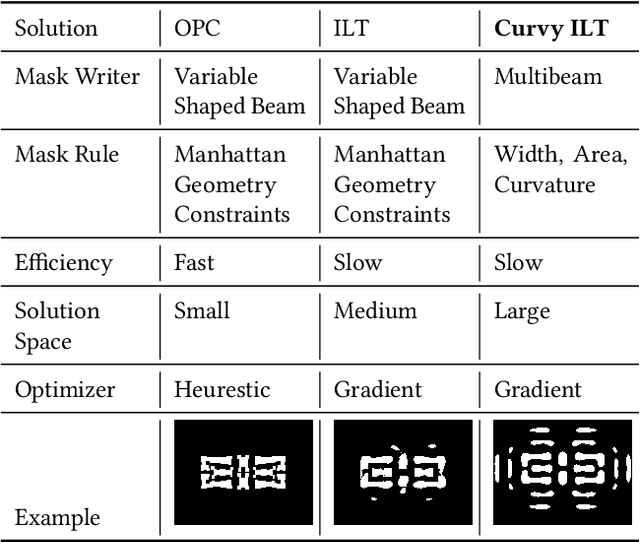

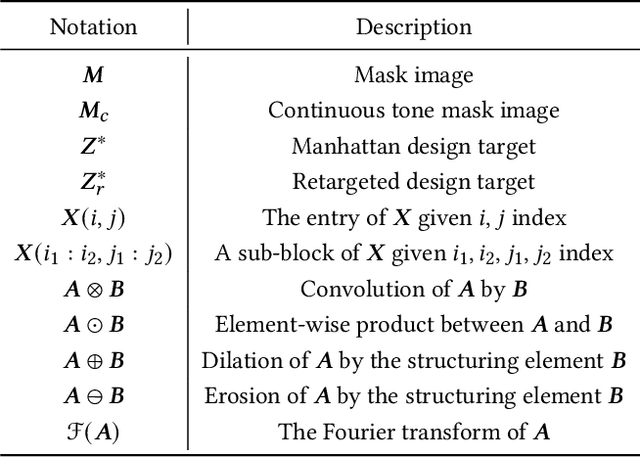
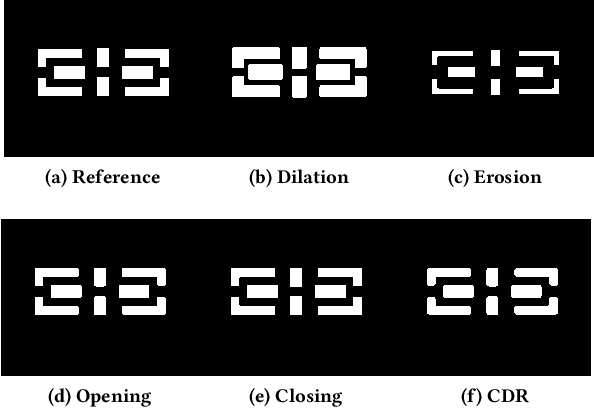
Abstract:Inverse Lithography Technology (ILT) has emerged as a promising solution for photo mask design and optimization. Relying on multi-beam mask writers, ILT enables the creation of free-form curvilinear mask shapes that enhance printed wafer image quality and process window. However, a major challenge in implementing curvilinear ILT for large-scale production is mask rule checking, an area currently under development by foundries and EDA vendors. Although recent research has incorporated mask complexity into the optimization process, much of it focuses on reducing e-beam shots, which does not align with the goals of curvilinear ILT. In this paper, we introduce a GPU-accelerated ILT algorithm that improves not only contour quality and process window but also the precision of curvilinear mask shapes. Our experiments on open benchmarks demonstrate a significant advantage of our algorithm over leading academic ILT engines.
Intelligent OPC Engineer Assistant for Semiconductor Manufacturing
Aug 27, 2024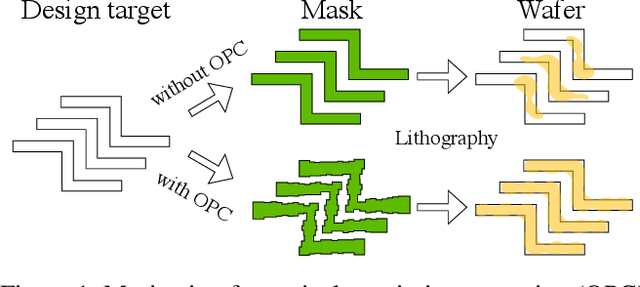
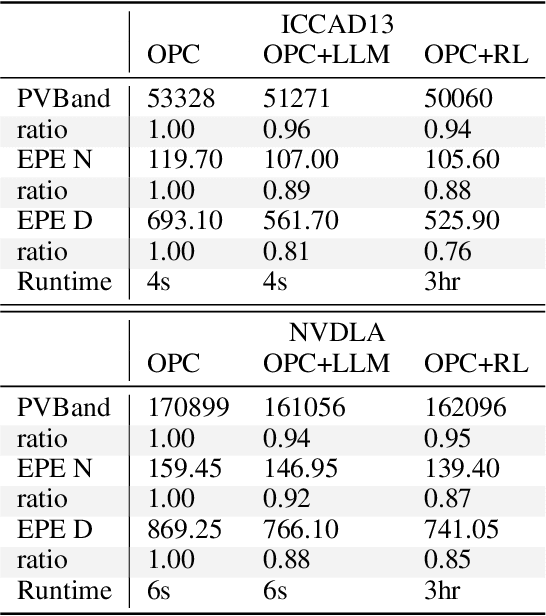
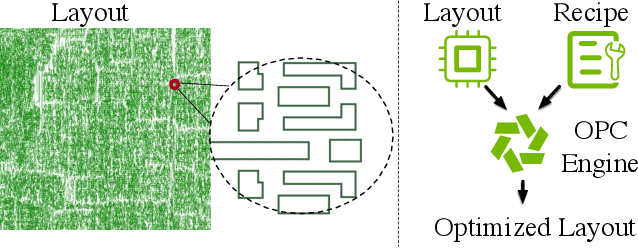
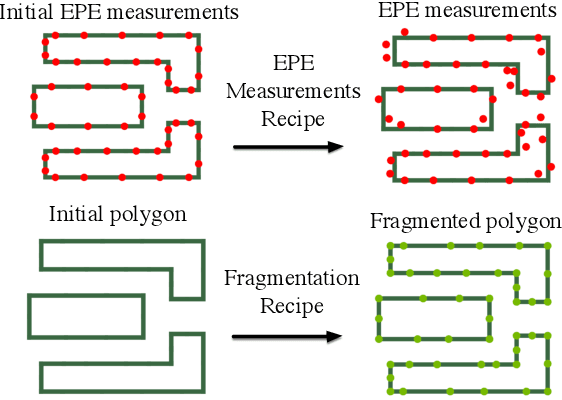
Abstract:Advancements in chip design and manufacturing have enabled the processing of complex tasks such as deep learning and natural language processing, paving the way for the development of artificial general intelligence (AGI). AI, on the other hand, can be leveraged to innovate and streamline semiconductor technology from planning and implementation to manufacturing. In this paper, we present \textit{Intelligent OPC Engineer Assistant}, an AI/LLM-powered methodology designed to solve the core manufacturing-aware optimization problem known as optical proximity correction (OPC). The methodology involves a reinforcement learning-based OPC recipe search and a customized multi-modal agent system for recipe summarization. Experiments demonstrate that our methodology can efficiently build OPC recipes on various chip designs with specially handled design topologies, a task that typically requires the full-time effort of OPC engineers with years of experience.
Revisiting VerilogEval: Newer LLMs, In-Context Learning, and Specification-to-RTL Tasks
Aug 20, 2024Abstract:The application of large-language models (LLMs) to digital hardware code generation is an emerging field. Most LLMs are primarily trained on natural language and software code. Hardware code, such as Verilog, represents only a small portion of the training data and few hardware benchmarks exist. To address this gap, the open-source VerilogEval benchmark was released in 2023, providing a consistent evaluation framework for LLMs on code completion tasks. It was tested on state-of-the-art models at the time including GPT-4. However, VerilogEval and other Verilog generation benchmarks lack failure analysis and, in present form, are not conducive to exploring prompting techniques. Also, since VerilogEval's release, both commercial and open-source models have seen continued development. In this work, we evaluate new commercial and open-source models of varying sizes against an improved VerilogEval benchmark suite. We enhance VerilogEval's infrastructure and dataset by automatically classifying failures, introduce new prompts for supporting in-context learning (ICL) examples, and extend the supported tasks to specification-to-RTL translation. We find a measurable improvement in commercial state-of-the-art models, with GPT-4 Turbo achieving a 59% pass rate on spec-to-RTL tasks. We also study the performance of open-source and domain-specific models that have emerged, and demonstrate that models can benefit substantially from ICL. We find that recently-released Llama 3.1 405B achieves a pass rate of 58%, effectively matching that of GPT-4 Turbo, and that the much smaller domain-specific RTL-Coder 6.7B models achieve an impressive 37% pass rate. However, prompt engineering is key to achieving good pass rates, and varies widely with model and task. A benchmark infrastructure that allows for prompt engineering and failure analysis is key to continued model development and deployment.
Differentiable Edge-based OPC
Aug 16, 2024Abstract:Optical proximity correction (OPC) is crucial for pushing the boundaries of semiconductor manufacturing and enabling the continued scaling of integrated circuits. While pixel-based OPC, termed as inverse lithography technology (ILT), has gained research interest due to its flexibility and precision. Its complexity and intricate features can lead to challenges in mask writing, increased defects, and higher costs, hence hindering widespread industrial adoption. In this paper, we propose DiffOPC, a differentiable OPC framework that enjoys the virtue of both edge-based OPC and ILT. By employing a mask rule-aware gradient-based optimization approach, DiffOPC efficiently guides mask edge segment movement during mask optimization, minimizing wafer error by propagating true gradients from the cost function back to the mask edges. Our approach achieves lower edge placement error while reducing manufacturing cost by half compared to state-of-the-art OPC techniques, bridging the gap between the high accuracy of pixel-based OPC and the practicality required for industrial adoption, thus offering a promising solution for advanced semiconductor manufacturing.
VerilogCoder: Autonomous Verilog Coding Agents with Graph-based Planning and Abstract Syntax Tree (AST)-based Waveform Tracing Tool
Aug 15, 2024



Abstract:Due to the growing complexity of modern Integrated Circuits (ICs), automating hardware design can prevent a significant amount of human error from the engineering process and result in less errors. Verilog is a popular hardware description language for designing and modeling digital systems; thus, Verilog generation is one of the emerging areas of research to facilitate the design process. In this work, we propose VerilogCoder, a system of multiple Artificial Intelligence (AI) agents for Verilog code generation, to autonomously write Verilog code and fix syntax and functional errors using collaborative Verilog tools (i.e., syntax checker, simulator, and waveform tracer). Firstly, we propose a task planner that utilizes a novel Task and Circuit Relation Graph retrieval method to construct a holistic plan based on module descriptions. To debug and fix functional errors, we develop a novel and efficient abstract syntax tree (AST)-based waveform tracing tool, which is integrated within the autonomous Verilog completion flow. The proposed methodology successfully generates 94.2% syntactically and functionally correct Verilog code, surpassing the state-of-the-art methods by 33.9% on the VerilogEval-Human v2 benchmark.
 Add to Chrome
Add to Chrome Add to Firefox
Add to Firefox Add to Edge
Add to Edge